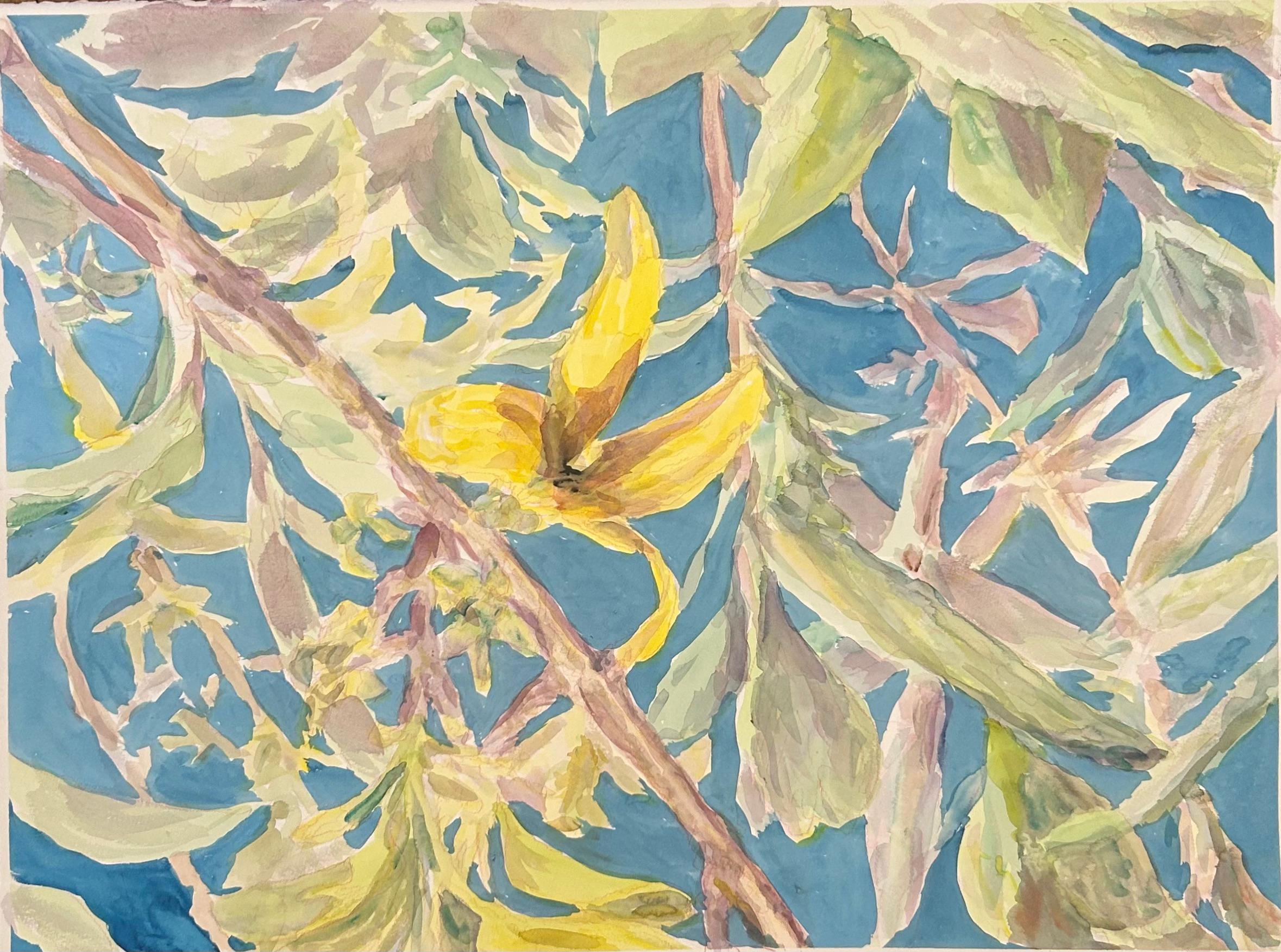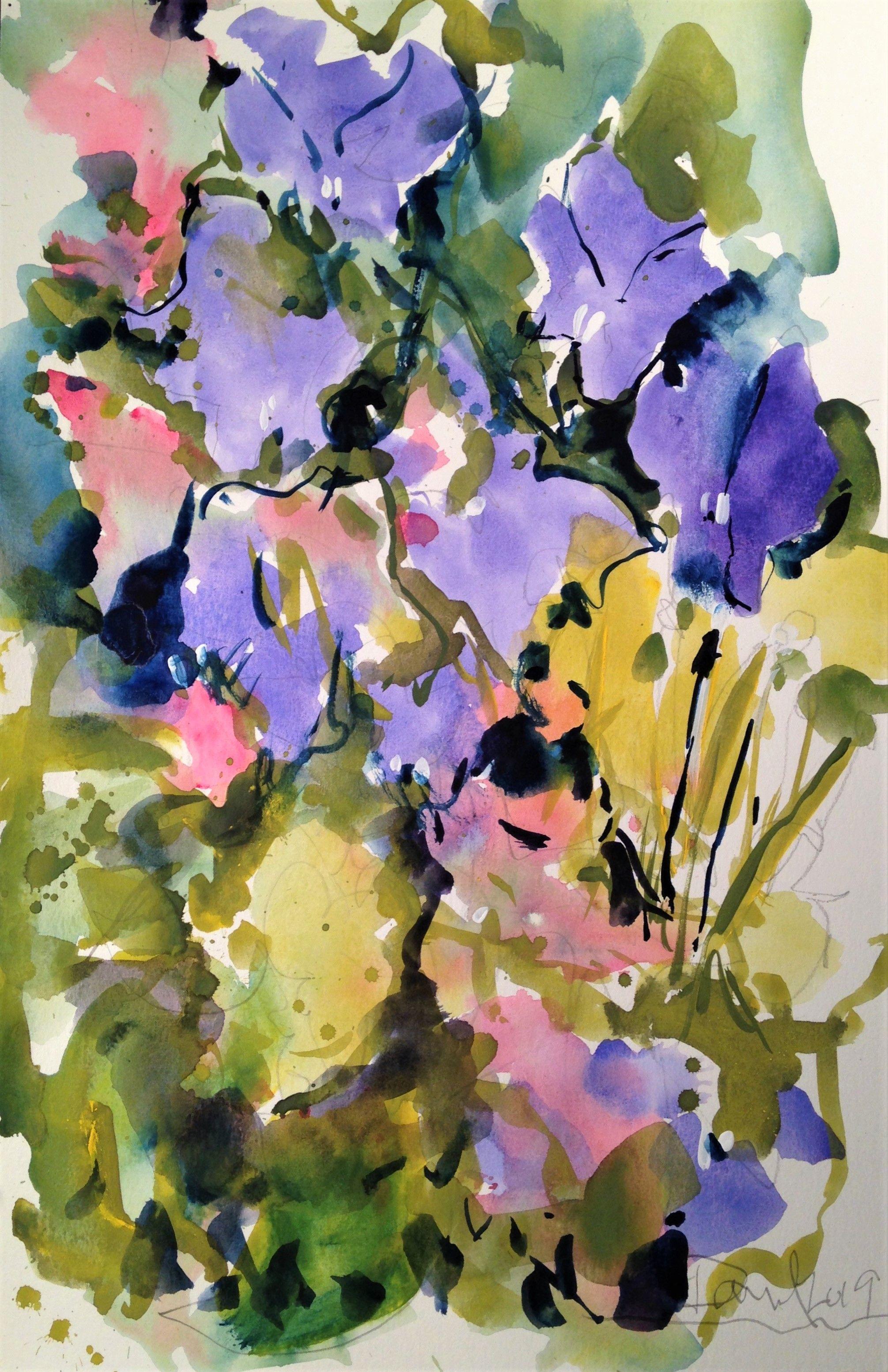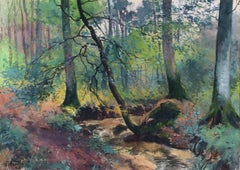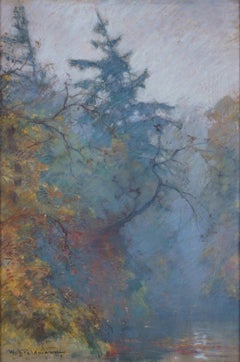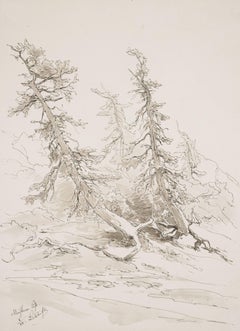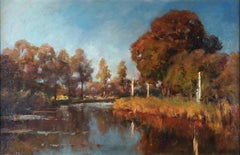Items Similar to Plant Impression in Locarno - Floral Crescendo -
Want more images or videos?
Request additional images or videos from the seller
1 of 6
Alexander FrenzPlant Impression in Locarno - Floral Crescendo -1895
1895
$881.83
$1,102.2920% Off
£656.35
£820.4320% Off
€736
€92020% Off
CA$1,207.89
CA$1,509.8620% Off
A$1,343.44
A$1,679.3020% Off
CHF 701.50
CHF 876.8820% Off
MX$16,348.23
MX$20,435.2820% Off
NOK 8,959.25
NOK 11,199.0720% Off
SEK 8,402.20
SEK 10,502.7520% Off
DKK 5,602.91
DKK 7,003.6420% Off
Shipping
Retrieving quote...The 1stDibs Promise:
Authenticity Guarantee,
Money-Back Guarantee,
24-Hour Cancellation
About the Item
Alexander Frenz (1861 Rheydt - 1941 Düsseldorf). Plant impression in Locarno. Gouache and watercolour. 35 x 23,5 cm (visible size), 49,5 x 38,5 cm (frame), signed "a.fRENZ" at lower right, place-inscribed and dated "LOCARNO 2. MAY [18]95" at lower left.
Framed. Surface partially rubbed.
- Floral Crescendo -
About the artwork
The vegetation depicted seems to spray and flash like fireworks. This internal movement results from an alternation of concretion and dissolution of form. The fanned out leaf at the centre of the picture acts as a central resting place, where the eye can always recover itself to dive back into the furious action of colour. The distribution of the individual fused pictorial elements is arranged like a tapestry realted to the foreground, so that the dissolved forms merge with the surface of the painting. In this painting - and this is its fundamental idea - the forces of creation coincide with those of art.
About the artist
Frenz was first trained by the cathedral sculptor Christian Mohr and the painter Johannes Niessen. From 1879 he studied at the Düsseldorf Academy of Art under Andreas Müller, Julius Roeting, Ernst Forberg, Eduard von Gebhard and later as a master student of Peter Janssen. He then spent a year as a private student of Franz von Lenbach in Munich. For Düsseldorf's jubilee in 1888, Frenz designed a 'living picture' with Teutons and Düsselixen. In 1891 he was awarded the Prussian State Prize, which he used to finance study trips to Naples and Rome. Further visits to Italy followed in 1893 and in 1895 Frenz travelled to Capri. After his studies, Frenz became an assistant to Hugo Crola at the Düsseldorf Academy. In 1904 he accepted a position at the Technical University of Aachen, where he succeeded Franz Reiff as head of the figure and landscape drawing and watercolour classes. In 1905 he was awarded the silver medal at the St Louis World's Fair. In 1909 Frenz gave up teaching at the university to work as a freelance artist. He lived in Berlin, Rome, Capri, Rapallo, Cologne and Bonn.
Frenz also turned to monumental painting. His commissions included the Augustinian Chapel and St Remigius' Church in Elberstadt, the Sacred Heart Church in Rheydt and the Jury Courtroom in Essen. Frenz also worked extensively as a graphic artist and book illustrator, providing illustrations for Houston Stewart Chamberlain's Richard Wagner book.
Frenz was married to the sister of the painter Arthur Kampf. However, unlike his brother-in-law Kampf, Frenz cultivated a more symbolist art and was particularly inspired by Arnold Böcklin and Franz von Stuck, earning him the nickname 'Rhenish Franz von Stuck'.
Frenz was a member of the academic artists' association Laetitia, the Freie Vereinigung Düsseldorfer Künstler, the artists' association Malkasten, the Verein Düsseldorfer Künstler zu gegenseitiger Unterstützung and the St. Lukas-Club.
"Together with Willy von Beckerath and Robert Böninger, Frenz is one of the most important Düsseldorf representatives of romantic New Idealism in connection with the symbolist-decorative aspirations of style art around 1900".
Carsten Roth
"Frenzel's talent is revealed in watercolours and drawings with a decorative content [...] more purely than in his lush, often very ephemeral oil paintings.
Walter Cohen
Selection of public collections that own works by Alexander Frenz:
Clemens-Sels-Museum Neuss, Museum Kunst Palast Düsseldorf, Reiff-Museum Aachen, Richard-Wagner-Stiftung Bayreuth, Stadtmuseum Bonn, Von-der-Heydt-Museum Wuppertal.
Selected Bibliography
Friedrich Schaarschmidt: Zur Geschichte der Düsseldorfer Kunst, Düsseldorf 1902.
Ulrich Thieme; Felix Becker: Allgemeines Lexikon der Bildenden Künstler von der Antike bis zur Gegenwart. Band 12, Leipzig 1916, S. 424.
Paul Horn: Düsseldorfer Graphik in alter und neuerer Zeit, Düsseldorf 1928.
Markowitz, Irene (Hrsg.): Die Düsseldorfer Malerschule, Düsseldorf 1969.
Hans Pfaffrath: Lexikon der Düsseldorfer Malerschule. 1819 - 1918. 1. Bd., München 1998.
Saur allgemeines Künstlerlexikon. Die bildenden Künstler aller Zeiten und Völker, Bd. 44, 2005, S. 435-437.
GERMAN VERSION
Alexander Frenz (1861 Rheydt - 1941 Düsseldorf). Pflanzenimpression in Locarno. Gouache und Aquarell. 35 x 23,5 cm (Sichtmaß), 49,5 x 38,5 cm (Rahmen), rechts unten mit „a.fRENZ“ signiert, links unten ortsbezeichnet und datiert „LOCARNO 2. MAI [18]95“.
Gerahmt. Oberfläche partiell berieben.
- Florales Crescendo -
zum Werk
Die dargestellte Vegetation wirkt so sprühend und aufblitzend wie ein Feuerwerk. Diese innere Bewegung resultiert aus einem Wechsel von Formkonkretion und Formauflösung. Dabei fungiert das bildmittig situierte aufgefächerte Blatt als zentraler Ruhepol, in dem sich der Blick immer wieder zu sammeln vermag, um erneut in das furiose Farbgeschehen einzutauchen. Die Verteilung der einzelnen miteinander verschmolzenen Bildelemente ist dabei wie ein auf den Vordergrund bezogener Bildteppich angeordnet, so dass sich die aufgelösten Formen mit der Malfläche verschwistern. In diesem Bild - und das ist seine tragende Idee - koinzidieren die Kräfte der Schöpfung mit denjenigen der Kunst.
zum Künstler
Eine erste Ausbildung erhielt Frenz durch den Dombildhauer Christian Mohr und den Maler Johannes Niessen. Anschließend studierte er ab 1879 an der Düsseldorfer Kunstakademie bei Andreas Müller, Julius Roeting, Ernst Forberg, Eduard von Gebhard und später als Meisterschüler von Peter Janssen. Danach war er in München ein Jahr lang Privatschüler Franz von Lenbachs. Zum Düsseldorfer Stadtjubiläum 1888 entwarf Frenz ein ‚lebendes Bild‘ mit Germanen und Düsselixen. 1891 erhielt er den preußischen Staatspreis, mit dem er Studienreisen nach Neapel und Rom finanzierte. 1893 folgten weitere Italienaufenthalte und 1895 reiste Frenz nach Capri. Nach dem Studium wurde Frenz an der Düsseldorfer Akademie Assistent von Hugo Crola. 1904 folgte er einem Ruf an die TH Aachen, wo er als Nachfolger von Franz Reiff die Klasse für Figuren- und Landschaftszeichnen sowie für Aquarellieren übernahm. 1905 erhielt er auf der Weltausstellung in St. Louis die silberne Medaille. 1909 gab Frenz die Hochschullehre auf, um sich ganz als freischaffender Künstler zu betätigen. Er lebte abwechselnd in Berlin, Rom, Capri, Rapallo, Köln und Bonn.
Frenz wandte sich auch der Monumentalmalerei zu. Er malte unter anderem die Augustiner Kapelle und die St.-Remigius-Kirche in Elberstadt, die Herz-Jesu-Kirche in Rheydt sowie im Auftrag des Justizministeriums den Essener Schwurgerichtssaal aus. Ebenso widmete sich Frenz ausgiebig der Grafik und der Buchillustration und stattete beispielsweise Houston Stewart Chamberlains Richard Wagner Buch mit Bildern aus.
Frenz war mit der Schwester des Malers Arthur Kampf verheiratet. Im Gegensatz zu seinem Schwager Kampf kultivierte Frenz jedoch eine stärker symbolistisch ausgerichtete Kunst und wurde insbesondere durch Arnold Böcklin und Franz von Stuck inspiriert, was ihm den Beinamen eines „rheinischen Franz von Stuck“ einbrachte.
Frenz war Mitglied der akademischen Künstlervereinigung Laetitia, der Freien Vereinigung Düsseldorfer Künstler, dem Künstlerverein Malkasten, dem Verein Düsseldorfer Künstler zu gegenseitiger Unterstützung und dem St. Lukas-Club.
„Frenz zählt mit Willy von Beckerath und Robert Böninger zu den wichtigsten Düsseldorfer Vertretern des romantischen Neu-Idealismus im Zusammenhang mit den symbolistisch-dekorativen Bestrebungen der Stilkunst um 1900.“
Carsten Roth
„Reiner als in den überzahlreichen, oft sehr flüchtigen Ölbildern offenbart sich Frenzels Begabung in Wasserfarbenbildern und Zeichnungen dekorativen Inhalts [...].“
Walter Cohen
Auswahl öffentlicher Sammlungen, die Werke von Alexander Frenz besitzen:
Clemens-Sels-Museum Neuss, Museum Kunst Palast Düsseldorf, Reiff-Museum Aachen, Richard-Wagner-Stiftung Bayreuth, Stadtmuseum Bonn, Von-der-Heydt-Museum Wuppertal.
Auswahlbibliographie
Friedrich Schaarschmidt: Zur Geschichte der Düsseldorfer Kunst, Düsseldorf 1902.
Ulrich Thieme; Felix Becker: Allgemeines Lexikon der Bildenden Künstler von der Antike bis zur Gegenwart. Band 12, Leipzig 1916, S. 424.
Paul Horn: Düsseldorfer Graphik in alter und neuerer Zeit, Düsseldorf 1928.
Markowitz, Irene (Hrsg.): Die Düsseldorfer Malerschule, Düsseldorf 1969.
Hans Pfaffrath: Lexikon der Düsseldorfer Malerschule. 1819 - 1918. 1. Bd., München 1998.
Saur allgemeines Künstlerlexikon. Die bildenden Künstler aller Zeiten und Völker, Bd. 44, 2005, S. 435-437.
- Creator:Alexander Frenz (1861 - 1941, German)
- Creation Year:1895
- Dimensions:Height: 13.78 in (35 cm)Width: 9.45 in (24 cm)Depth: 0.79 in (2 cm)
- Medium:
- Movement & Style:
- Period:
- Condition:
- Gallery Location:Berlin, DE
- Reference Number:1stDibs: LU2438212326242
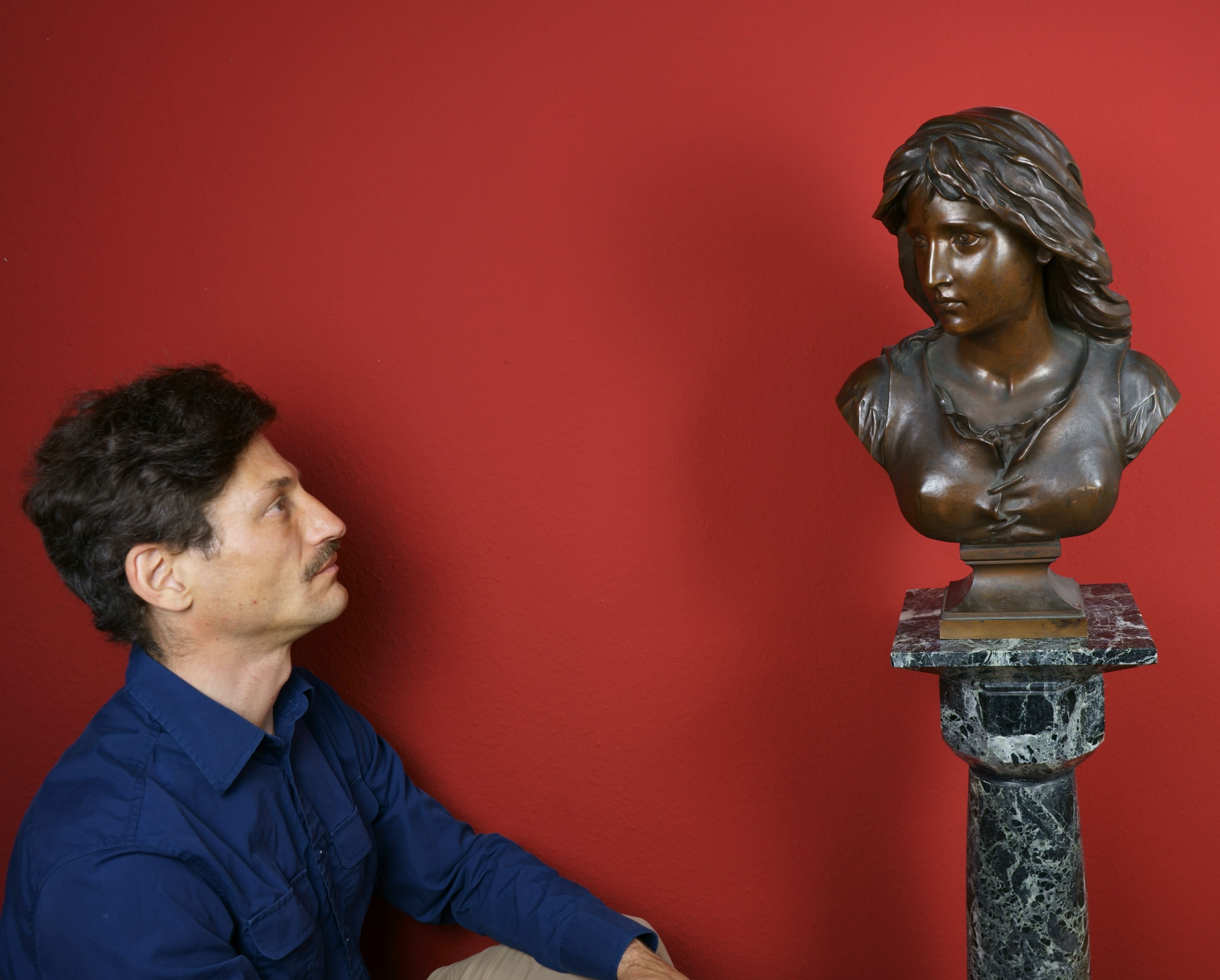
About the Seller
5.0
Gold Seller
Premium sellers maintaining a 4.3+ rating and 24-hour response times
Established in 2014
1stDibs seller since 2023
20 sales on 1stDibs
- ShippingRetrieving quote...Shipping from: Berlin, Germany
- Return Policy
Authenticity Guarantee
In the unlikely event there’s an issue with an item’s authenticity, contact us within 1 year for a full refund. DetailsMoney-Back Guarantee
If your item is not as described, is damaged in transit, or does not arrive, contact us within 7 days for a full refund. Details24-Hour Cancellation
You have a 24-hour grace period in which to reconsider your purchase, with no questions asked.Vetted Professional Sellers
Our world-class sellers must adhere to strict standards for service and quality, maintaining the integrity of our listings.Price-Match Guarantee
If you find that a seller listed the same item for a lower price elsewhere, we’ll match it.Trusted Global Delivery
Our best-in-class carrier network provides specialized shipping options worldwide, including custom delivery.More From This Seller
View AllSummer Forest Landscape, 1915 / - The Forest Walk -
Located in Berlin, DE
Stanislas Warnie (1879-1958), Summer Forest Landscape, 1915. Watercolor, 31.5 cm x 45 cm (passepartout), 50.5 cm x 63.5 cm (frame), signed "S. Warnie" at lower left and dated "1915"....
Category
1910s Art Nouveau Landscape Drawings and Watercolors
Materials
Watercolor
$623 Sale Price
20% Off
Impressionist Autumn Landscape with Lake / - Diffuse Concretion -
Located in Berlin, DE
Wilhelm Feldmann (1859 Lüneburg - 1932 Lübeck), Impressionist autumn landscape with lake, around 1905. Pastel on cardboard, 46 cm x 31 cm (inside dimension), 52 cm x 37 cm (frame), s...
Category
Early 1900s Impressionist Landscape Paintings
Materials
Gouache
Woodland / - The Inner Drama of the Landscape -
Located in Berlin, DE
Eduard Peithner von Lichtenfels (1833 Vienna - 1913 Berlin), Woodland, 1884. Watercolor and pen and ink on drawing paper, 30.4 cm x 22.5 cm, signed, dated and inscribed by the artist...
Category
1880s Landscape Drawings and Watercolors
Materials
Paper
Late Summer River Landscape / - Realistic Impression -
By Jan Hillebrand Wijsmüller
Located in Berlin, DE
Jan Hillebrand Wijsmuller (1855 Amsterdam - 1925 ibid.), Late Summer River Landscape, oil on canvas, relined, 34 x 56 cm (inside measurement), 43 x 64 cm (frame), signed J[an] H[illebrand] Wijsmuller at lower right.
- in good condition, the frame with isolated bumped spots
- Realistic Impression -
About the artwork
The panoramic landscape format shows a river landscape, with the course of the river, which curves to the right, leading the eye into the depths of the picture and tempting it to continue the landscape in the imagination beyond the visible area. At the same time, however, the fact that the landscape is not visible through the bend in the river focuses our gaze on the entirety of the landscape depicted, without prompting us to focus on distant details. Accordingly, the brushstroke is not designed to render details with realistic precision. In the front left area of the river there is even a completely free brushwork, trained by Impressionism, which nevertheless remains committed to representational and convincingly suggests the movement of the water.
Regardless of the distance of the observer, the entire picture is painted with the same broad brushstroke, so that the landscape is given as an impression. And yet this impression is not ephemeral, as in the case of French Impressionism, to put it exaggeratedly, but reveals to us the essence of the landscape in all its richness. This is why the Dutch variant of Impressionism is always also a realism, although the pictures appear less progressive, but still contain a dimension of landscape painting that is lost with progress.
In the impression, the reality of the landscape is revealed, and this happens as we experience the landscape in the visual impression. Wijsmuller does not depict houses or people in order to allow the experience of the landscape to fully unfold. The experience is determined first and foremost by the river, which does not flow into the picture from our point of view, but towards us. Where the river begins to bend, the water is churned by a rapids. Toward us, the riverbed widens and the water comes to rest, covering the entire width of the foreground like a mirror.
The stillness of the water corresponds to the evening mood of the late summer landscape, in which the warm tones of the evening light blend with the yellow and brown tones of the plants. A gentle, almost idyllic reality, carried by the brushstroke, yet animated by a liveliness that is also made visible by the brushstroke. The broad, dynamically placed brushstrokes evoke the movement of the treetops and animate even the immobile reeds, while the trunks on the right bank, executed in virtuoso white strokes that seem like markings, make the sunlight shine. On the other bank, a carpet of light also spreads out, its energetic effect again expressed in the brushstroke. The dynamic of the landscape is further enhanced by the complementary color contrasts between the greens, yellows, and browns on the one hand and the blue of the all-encompassing sky on the other. A contrast that is intensified by the reflection in the water.
The evening coming to rest of the landscape is thus at the same time an all-encompassing contrasting and yet in itself harmonious movement. This reality becomes accessible to us as an experience in the impression of the landscape.
About the artist
Jan Hillebrand Wijsmuller entered the Royal Academy of Arts in Amsterdam in 1876 and studied under the innovative Professor August Allebé, who was famous for the Amsterdam Impressionism, also known as the Allebé School.
In 1877, Wijsmuller transferred to the Hague Academy of Art, and thus to the Hague School, and then completed his studies at the Brussels Academy of Art. Returning to the Netherlands, Wijsmuller opened his own studio in Amsterdam.
In 1883 he won the prestigious Young Artist Award, donated by Willink van Collen, which made Wijsmuller a well-known and sought-after artist.
Wijsmuller was a member of the Societät Arti et Amicitiae Amsterdam and the Pulchri Studio in The Hague.
Wijsmuller belongs to the second generation of the Hague School. While Vincent van Gogh described the protagonists of the first generation to his brother Theo as "the great gray people," the second generation, and Wijsmuller in particular, used a much more colorful palette. His oeuvre makes him a major player in Dutch Impressionism...
Category
1890s Impressionist Landscape Paintings
Materials
Canvas
$3,642 Sale Price
20% Off
Landscape verso Forest interior / - Landscape as a space of imagination -
Located in Berlin, DE
Herbert Seidel (1906 Berlin - 1974 Rüdersdorf), Landscape verso Forest interior, around 1950. India ink on grained, bleached paper, 40.5 x 58 cm, signed “Herbert Seidel” in pencil on...
Category
1950s Abstract Landscape Drawings and Watercolors
Materials
Paper
Still life with meadow flowers - The beauty of meadow flowers -
Located in Berlin, DE
Jean-Baptiste Robie (1821 Brussels - 1910 ibid.). Still life with meadow flowers. Oil on wood, 24.5 x 18.5 cm (inside measurement), 37 x 31 cm (frame), signed and dated (difficult to...
Category
Early 1900s Naturalistic Still-life Paintings
Materials
Oil, Canvas
$3,067 Sale Price
20% Off
You May Also Like
Floral Watercolor Landscape on Paper
By Renelio Marin
Located in New York, NY
Renelio Marin is a visual artist with a diverse range of influences and styles. Born in Cuba, he received his graduate degree from the San Alejandro School of Fine Arts in Havana in ...
Category
2010s Abstract Impressionist Landscape Drawings and Watercolors
Materials
Watercolor
Spring In My Town. Vertical, floral, nature, landscape, mountains, Switzerland
Located in Oslo, NO
The painting "Spring In My Town" (50x60 cm), painted in oil on canvas in a vertical format, immerses the viewer in the atmosphere of spring awakening. In the center of the compositio...
Category
2010s Post-Impressionist Landscape Paintings
Materials
Canvas, Oil
Landscape
Located in San Francisco, CA
This artwork "Landscape" c.1950 is a watercolor on paper by Mexican artist Fernando Casas Castanos, 1903-1981. It is signed at the upper right corner by...
Category
Mid-20th Century Impressionist Landscape Drawings and Watercolors
Materials
Watercolor
Floral #39, Painting, Watercolor on Watercolor Paper
By Daniel Clarke
Located in Yardley, PA
Can one conceive of any reason for a flower's beauty excepting our ability to enjoy their exquisite splendor? Of course there are scientific reasons for flowers beautiful colors such...
Category
2010s Impressionist Drawings and Watercolor Paintings
Materials
Watercolor
Monnar Garden, India December
By Phillip Alder
Located in Brecon, Powys
Delicate watercolour of a garden in India in December
Mounted ready for framing
Category
2010s Impressionist Landscape Drawings and Watercolors
Materials
Watercolor
Floral Gardens - Early 20th Century Watercolor Landscape by Annie L Pressland
Located in Watford, Hertfordshire
Annie L Pressland (1892 - 1933)
A watercolor painter of flowers, gardens and still lives, she was born on 2 July 1862, the daughter of Caleb Pressla...
Category
Early 19th Century Impressionist Landscape Drawings and Watercolors
Materials
Watercolor
